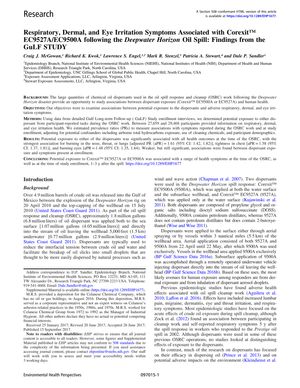Respiratory, Dermal, and Eye Irritation Symptoms Associated with Corexit EC9527A/EC9500A Following the Deepwater Horizon Oil Spill: Findings from the GuLF Study
September 2017
in “
Environmental health perspectives
”

TLDR Exposure to Corexit dispersants during the oil spill cleanup was linked to increased respiratory and eye irritation symptoms in workers.
The study analyzed the health effects of Corexit™ EC9527A/EC9500A dispersants on workers involved in the Deepwater Horizon oil spill cleanup, using data from the GuLF Study with 27,659 to 29,468 participants. It found significant associations between exposure to the dispersants and a range of health symptoms, including respiratory issues like burning in the nose, throat, or lungs (aPR=1.61), chest tightness (aPR=1.58), and eye irritation such as burning eyes (aPR=1.48). These associations were strongest during the oil spill response and cleanup but remained significant for some symptoms up to three years later. The study controlled for confounding factors and indicated that direct exposure to dispersants was more strongly linked to adverse health outcomes than indirect exposure.